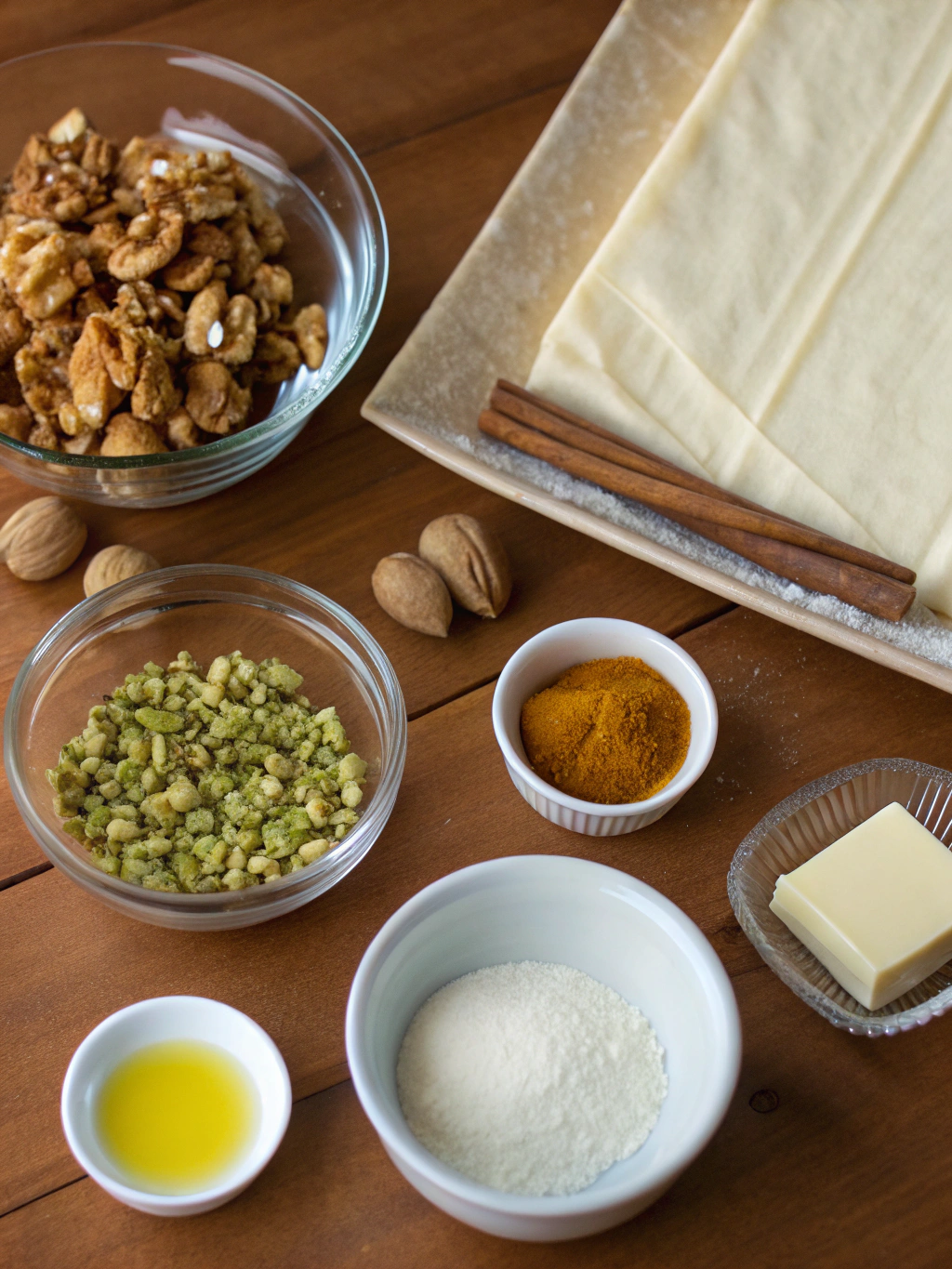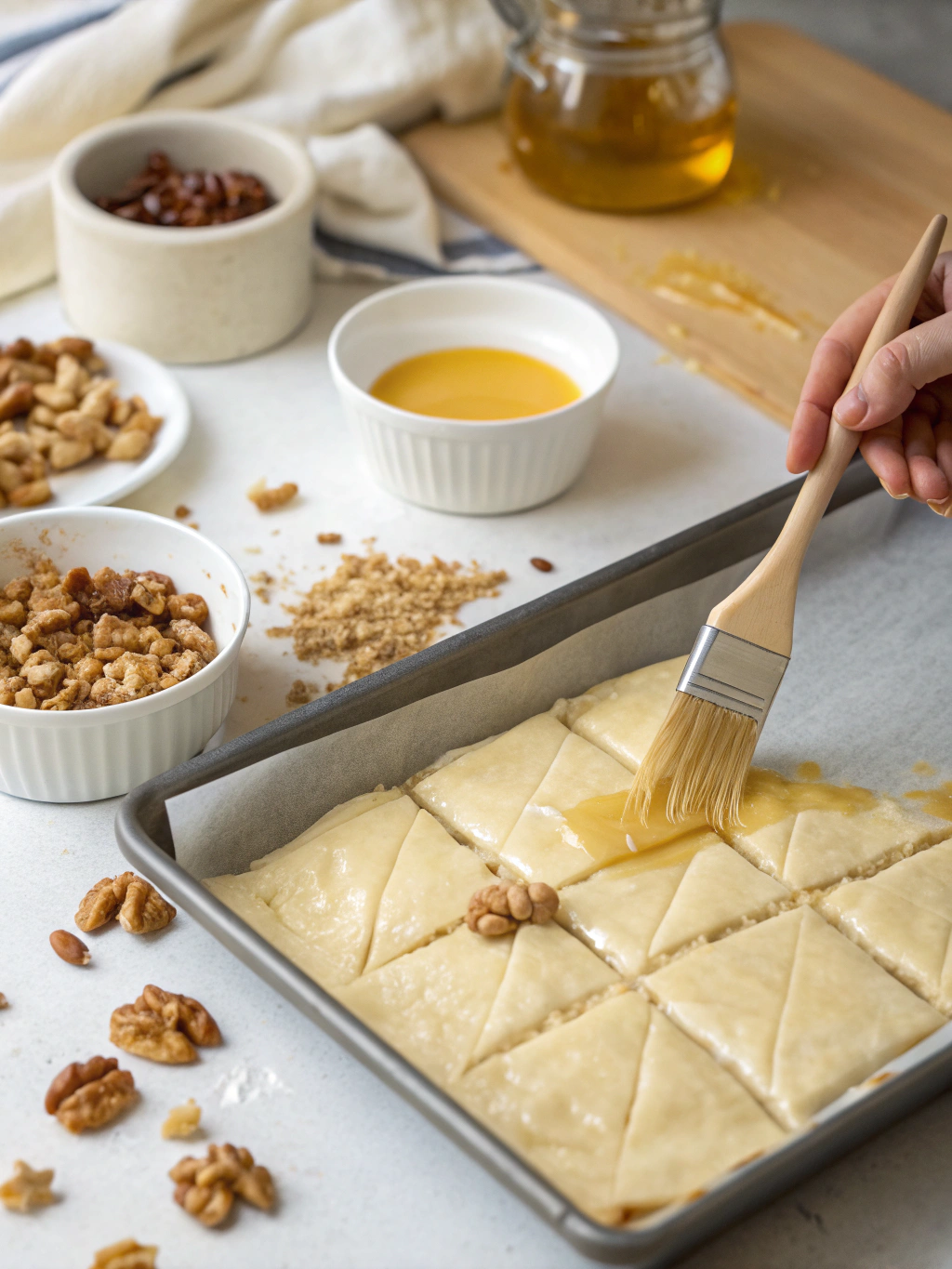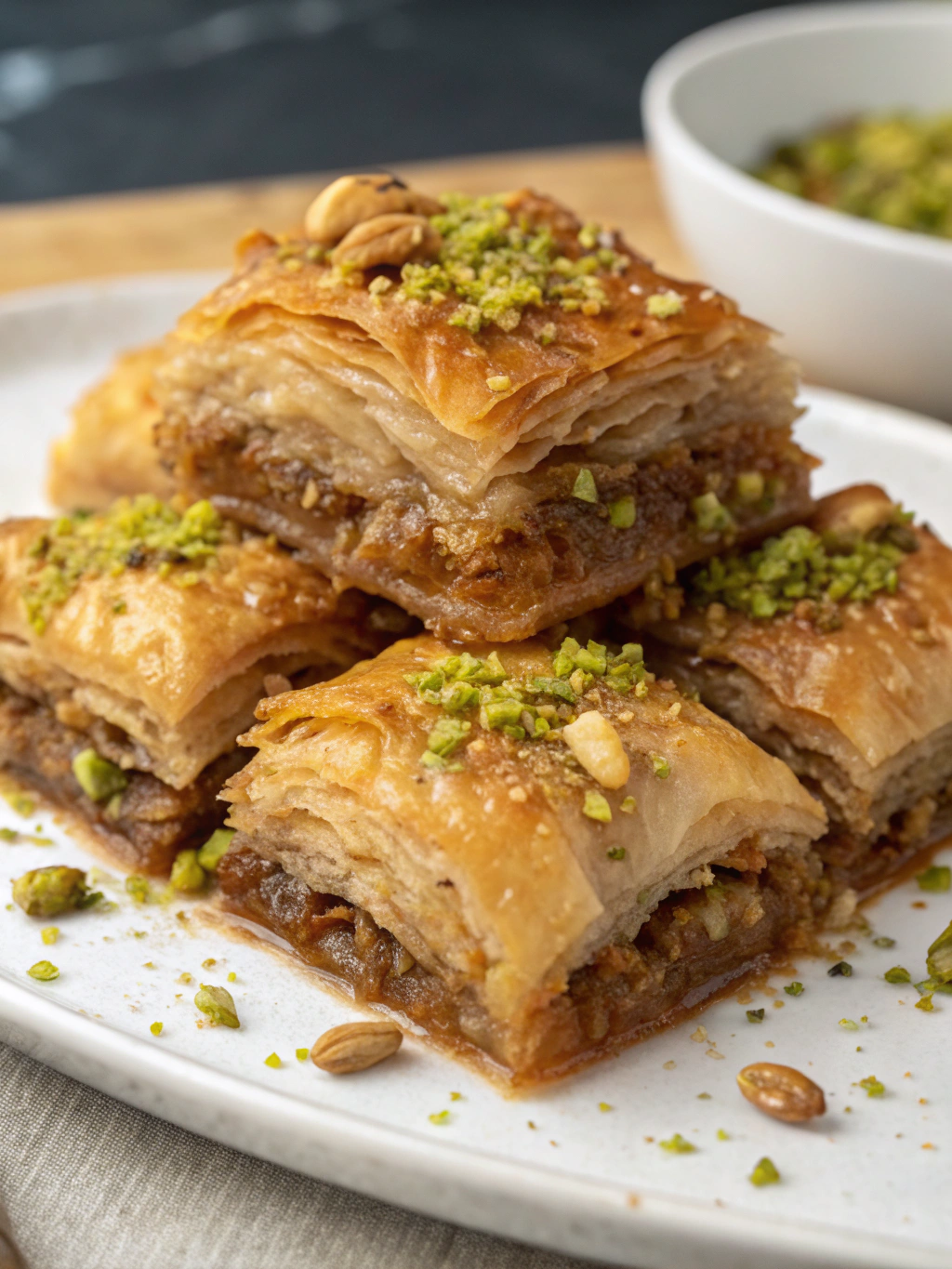How to Make Greek Dessert Baklava | Easy Authentic Recipe
How to Make Greek Dessert Baklava | Easy Authentic Recipe
Table of Contents
Have you ever wondered why greek dessert baklava has captivated dessert lovers for centuries? Is it the hypnotic layers of crisp phyllo, the aromatic honey syrup, or the rich nutty filling that makes this dessert so irresistible? This ancient treat has survived through generations for good reason – it’s simply divine.
Today, I’m sharing an authentic baklava recipe that brings the essence of Greek bakeries right to your kitchen. This traditional dessert might seem intimidating at first glance, but with my step-by-step guide, you’ll create bakery-quality baklava that will impress everyone at your table.
The secret to perfect baklava lies in the balance between crispy layers and sweet syrup. Let’s dive into this delicious journey of creating one of the world’s most beloved desserts.
Ingredients List

Gathering quality ingredients is crucial for creating an authentic greek dessert baklava. The aromatic combination of nuts, honey, and spices creates that distinctive flavor profile we all love.
For the Phyllo Layers:
- 1 pound (about 24 sheets) phyllo dough, thawed according to package instructions
- 1 cup (2 sticks) unsalted butter, melted
- Optional: 2 tablespoons olive oil (can be mixed with butter for easier spreading)
For the Nut Filling:
- 4 cups finely chopped nuts (traditionally walnuts, but you can use a mix of walnuts, pistachios, and almonds)
- 1 teaspoon ground cinnamon
- 1/4 teaspoon ground cloves
- 1/4 teaspoon ground cardamom (optional but adds authentic flavor)
- 1/2 cup granulated sugar
- Zest of 1 lemon (optional)
For the Syrup:
- 1 cup honey (Greek honey preferred, but any quality honey works)
- 1 cup granulated sugar
- 3/4 cup water
- 1 cinnamon stick
- 2-3 whole cloves
- 1 strip of lemon peel
- 1 tablespoon fresh lemon juice
- 1 teaspoon vanilla extract or 1 tablespoon rose water (for authentic flavor)
Ingredient Substitutions: If walnuts aren’t available, almonds make an excellent substitute. For a dairy-free version, use clarified coconut oil instead of butter. Can’t find phyllo? While not traditional, puff pastry can work in a pinch, though the texture will differ.
Timing
Preparing this greek dessert baklava requires patience, but the results are worth every minute. Breaking down the process makes it manageable and less intimidating.
- Preparation time: 45 minutes (includes chopping nuts and preparing phyllo)
- Assembly time: 30 minutes
- Baking time: 50-60 minutes
- Cooling and soaking time: At least 4 hours (preferably overnight)
- Total time: Approximately 6 hours (including cooling)
While this might seem lengthy, the actual hands-on time is only about 75 minutes – 30% less than many traditional recipes that can require constant attention. Most of the time is passive cooling and soaking, during which the magic happens as the syrup infuses the layers.
Step-by-Step Instructions

Follow these detailed steps to create perfect baklava every time. The key is working methodically and keeping your phyllo dough properly covered while you work.
Step 1: Prepare Your Workspace
Preheat your oven to 325°F (165°C). Grease a 9×13 inch baking pan with butter or cooking spray. Unwrap your phyllo dough and cover it with a slightly damp kitchen towel to prevent it from drying out. Have your melted butter ready with a pastry brush nearby.
Step 2: Make the Nut Filling
In a food processor, pulse the nuts until finely chopped but not powdered – you want some texture. Transfer to a bowl and mix with cinnamon, cloves, cardamom, sugar, and lemon zest if using. The mixture should be fragrant and well-combined.
Step 3: Begin Layering
- Place one sheet of phyllo in the bottom of your prepared pan, letting any excess hang over the edges.
- Brush generously with melted butter, ensuring you reach the corners and edges.
- Repeat with 7 more sheets of phyllo, brushing each with butter.
- Pro tip: Don’t worry if sheets tear – simply patch them together. This rustic approach is part of homemade baklava’s charm!
Step 4: Add First Nut Layer
Sprinkle 1/3 of your nut mixture evenly over the phyllo layers. Gently press down to create an even surface. The pressing helps create distinct layers in the final dessert.
Step 5: Continue Layering
- Add 4 more sheets of phyllo, brushing each with butter.
- Add another 1/3 of the nut mixture.
- Repeat with 4 more buttered phyllo sheets and the final 1/3 of nuts.
- Finish with 8-10 sheets of phyllo on top, buttering each layer generously.
Step 6: Prepare for Baking
Trim any overhanging phyllo with kitchen scissors. Brush the top with a final layer of butter. Using a sharp knife, cut diagonal lines through all layers to create diamond shapes, or cut into squares if preferred. Be sure to cut all the way to the bottom of the pan.
Step 7: Bake to Golden Perfection
Bake in the preheated oven for 50-60 minutes, until the top is golden brown and crisp. If it’s browning too quickly, cover loosely with foil. The baklava should have a deep amber color when done.
Step 8: Prepare the Syrup
While the baklava is baking, combine water, sugar, honey, cinnamon stick, cloves, and lemon peel in a saucepan. Bring to a boil, then reduce heat and simmer for 15-20 minutes until slightly thickened. Remove from heat, discard spices, and stir in lemon juice and vanilla or rose water.
Step 9: The Critical Syrup Step
Here’s the secret to perfect baklava: temperature contrast. Pour the room temperature syrup over the hot baklava immediately after it comes out of the oven. You’ll hear a satisfying sizzle as the syrup begins to be absorbed. Alternatively, you can pour hot syrup over cooled baklava – just never hot on hot or cold on cold.
Step 10: Rest and Absorb
Allow the baklava to sit uncovered at room temperature for at least 4 hours, preferably overnight. This resting period is crucial as it allows the syrup to fully penetrate the layers and the flavors to meld together beautifully.
Nutritional Information
Understanding the nutritional content of greek dessert baklava helps you enjoy this treat mindfully. While it’s certainly indulgent, the nuts provide beneficial nutrients.
Per serving (1 piece, approximately 2.5″x2.5″):
- Calories: 330
- Total Fat: 21g (Saturated Fat: 7g)
- Cholesterol: 25mg
- Sodium: 95mg
- Total Carbohydrates: 35g (Dietary Fiber: 2g, Sugars: 23g)
- Protein: 5g
The walnuts in traditional baklava contain omega-3 fatty acids, which support heart health. According to nutrition data, a serving of baklava provides approximately 8% of your daily recommended calcium intake and 6% of your daily iron needs, primarily from the nuts.
Healthier Alternatives for the Recipe
While traditional baklava is a treat to be savored occasionally, these modifications can create a slightly healthier version without sacrificing the authentic taste experience.
- Reduce the butter: Use a mixture of olive oil and butter (3:1 ratio) to decrease saturated fat while maintaining moisture.
- Lower the sugar: Reduce sugar in the syrup by up to 25% and compensate with an extra tablespoon of honey for natural sweetness.
- Increase nut nutrition: Use raw, unsalted nuts and add 2 tablespoons of ground flaxseed to the filling for added omega-3s and fiber.
- Whole grain option: Some specialty stores offer whole grain phyllo dough, which provides more fiber than the traditional version.
- Portion control: Cut baklava into smaller pieces (1.5″ diamonds) to enjoy the full flavor experience with fewer calories.
Serving Suggestions
Elevate your baklava experience with these serving ideas that honor tradition while adding a personal touch to this beloved dessert.
- Serve with a small scoop of vanilla bean or mastic ice cream for a delightful temperature contrast.
- Pair with Greek coffee or strong espresso to balance the sweetness.
- For an elegant presentation, dust with finely ground pistachios just before serving.
- Create a dessert board with baklava, fresh figs, Greek yogurt with honey, and a selection of cheeses.
- For a modern twist, serve with a citrus sorbet or a small glass of chilled Sauternes dessert wine.
In Greece, baklava is often enjoyed as an afternoon treat with coffee or as part of celebrations. Consider serving it at room temperature for the best flavor and texture experience.
Common Mistakes to Avoid
Even experienced bakers can encounter challenges when making baklava. Here are the most common pitfalls and how to avoid them:
- Letting phyllo dry out: Always keep unused phyllo covered with a damp (not wet) towel while working.
- Rushing the baking process: Baking at too high a temperature can burn the top before the middle layers are cooked. Stick to 325°F for even baking.
- Using the wrong syrup temperature: Remember the rule: hot baklava gets room temperature syrup, or room temperature baklava gets hot syrup.
- Cutting after baking: Always cut baklava before baking for clean lines and proper syrup absorption.
- Over-processing the nuts: Pulse nuts just until chopped but still textured. Over-processing creates a paste-like consistency that won’t provide the right texture.
- Skimping on butter: Each phyllo sheet needs a light but complete coating of butter to achieve the right flakiness.
Storing Tips for the Recipe
Proper storage ensures your baklava stays fresh and delicious for days or even weeks after preparation.
- Room temperature storage: Baklava can be stored at room temperature in an airtight container for up to 2 weeks. The honey in the syrup acts as a natural preservative.
- Refrigeration: While not traditionally refrigerated, you can store baklava in the refrigerator for up to 3 weeks. Allow it to come to room temperature before serving for the best texture and flavor.
- Freezing: Baklava freezes beautifully for up to 4 months. Wrap individual portions in plastic wrap, then aluminum foil, and place in a freezer-safe container.
- Thawing: Thaw frozen baklava overnight in the refrigerator, then bring to room temperature before serving.
- Make-ahead tip: You can assemble and freeze unbaked baklava, then bake directly from frozen (adding about 15 minutes to the baking time).
Conclusion
Creating authentic Greek baklava at home is a rewarding culinary adventure that connects you to centuries of tradition. The harmonious blend of crispy phyllo, aromatic nuts, and sweet honey syrup creates a dessert experience unlike any other.
While it requires some patience and attention to detail, the process is straightforward when broken down into manageable steps. The result is a show-stopping dessert that will have friends and family raving.
Have you tried making this traditional Greek dessert? I’d love to hear about your baklava experiences in the comments below! Share your photos, tips, or questions – and if you enjoyed this recipe, don’t forget to explore our other Mediterranean dessert recipes for more sweet inspiration.
Did you try this Recipe ?
There are no reviews yet. Be the first one to write one.

